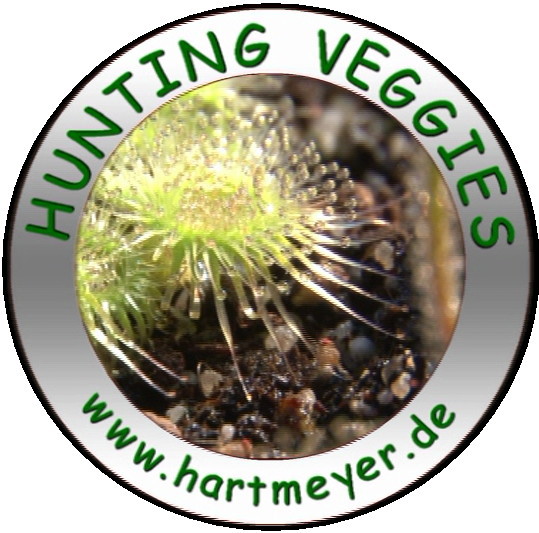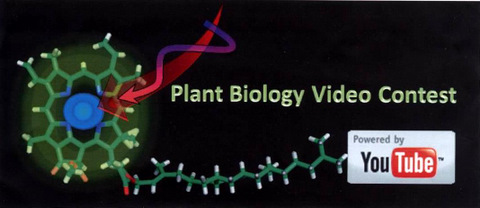 Pulvinus und Bewegung
bei Byblis, unsere Zeitraffer-Filme auf YouTube Pulvinus und Bewegung
bei Byblis, unsere Zeitraffer-Filme auf YouTube
14 Tage Zeitraffer von Byblis liniflora
zeigen eindeutig, dass die karnivore Gattung Byblis ihre
Blätter mittels Pulvinus bewegt (eine Verdickung an der
Blattbasis welche Bewegung ermöglicht). Das wurde zuerst 2008
von Brian Barnes (USA) bemerkt und veröffentlicht.
Bemerkenswerterweise wurde dies von den Autoren, welche die
verschiedenen Byblisarten in der Vergangenheit beschrieben
übersehen, denn diese hochinteressante Eigenschaft wird dort
nirgends erwähnt. Jedenfalls konnten wir keine derartige
Publikation vor der Veröffentlichung durch Brian finden. Daher
gratulieren wir Brian Barnes, der zurzeit ICPS Director of Conservation
(Vorstandsmitglied der ICPS mit Verantwortungsbereich Naturschutz) und
Präsident der Florida Karnivorengesellschaft ist, zu seinen
faszinierenden Forschungen.
Unser aktueller "Zwei Wochen in einer Minute"
Zeitrafferfilm ist eine Kooperation mit Brian und ermöglicht
jedem, eine Gattung zu erleben (alle Byblisarten bilden Pulvini) die
nicht nur gelegentlich ein Blatt bewegt, sondern insgesamt quasi
pausenlos in Bewegung ist.
Pulvinus
and movement in Byblis, our
time-lapse films on YouTube
14
days time lapse of Byblis
liniflora show clearly that the
carnivorous genus Byblis
moves its leaves by pulvinus (thickening at the leaf or flower
stalk base, enabling movement).
This has first been noticed and published in 2008 by Brian Barnes
(USA). Interestingly enough this amazing feature has apparently not
been recognized or mentioned by other authors who described the
different species of the Rainbow Plant in the past. We could find no
text mentioning this fact prior to Brians examinations. So our
congratulation for this finding goes to Brian Barnes (USA), ICPS
director of conservation and president of the Florida CPS. Our topic
time-lapse footage enables everybody to enjoy a genus (all Byblis
species move by pulvinus) that not only moves a leaf by occasion, no,
the "2 weeks in 1 minute" compression shows a nearly permanently moving
plant.
|
Aber wofür
soll die Bewegung gut sein?
Das ist jetzt leicht zu sehen: Ein
neues Fangblatt und ein Blütenstängel (mit nur einer
Knospe an der Spitze) wachsen gemeinsam vom Spross fast senkrecht nach
oben, um Fluginsekten zu erbeuten bis sich die Blüte
öffnet. Dann bildet sich in der gemeinsamen Blattachse ein
Pulvinus und das klebrige Fangblatt bewegt sich nach unten, um keine
anfliegenden Bestäuber zu gefährden. Die offene
Blüte wird weiterhin aufrecht gehalten bis sie
bestäubt wurde. Danach verdickt sich der Pulvinus weiter und
jetzt wird der Blütenstängel mit der reifenden
Samenkapsel abgesenkt, bis diese mit der Oberseite nach unten zum Boden
weist. So werden die reifen Samen aus der sich öffnenden
Samenkapsel direkt auf den Boden gestreut, ohne in der
äußerst klebrigen Pflanze hängenzubleiben.
Weil die überwiegend einjährigen Pflanzen
(außer Byblis aff. gigantea) sehr schnell wachsen, erweckt die
Zeitrafferaufnahme einer Pflanzengruppe (2. Film) den faszinierenden
Eindruck eines Balletts.
But such a movement,
what is it good for?
Easy to see now: a new trapping
leaf and a flower stalk (wearing one flower bud on the tip) both emerge
from the leaf axil and both grow up erect to catch flying prey until
the flower bud opens. Now a pulvinus is developed in the common leaf
axil and the sticky trapping leaf moves down, not to endanger
approaching pollinators. The flower is still hold erect. After
pollination took place, the pulvinus shows a new thickening and now the
flower stalk with the ripening seed-pot on the tip moves down and soon
after that movement is finished the seed-pot facing down to the soil
opens and seeds are released without sticking to to the gluey plant.
Due to the fact that the mainly annual plants (except Byblis aff. gigantea) are rapid growers, the time-lapse
of some plants (2nd movie) looks like a
fascinating group of ballet dancers.
|

